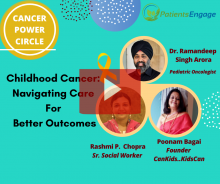
A recent qualitative study evaluated the challenges of accessing health care for childhood cancer in India and the effect this had on treatment of children and impact on caregivers. In an email interview, Dr Neha Faruqui in consultation with other experts helped address questions raised by PatientsEngage.
Childhood cancers such as leukemia, retinoblastoma and meningiomas are commonly seen in India for the age group of 18 and under. The time period between the first onset of symptoms to diagnosis is anywhere from 0.3 to 521 weeks (~10 years). This staggering range of time gap is often used to quantify the challenges of accessing health care in childhood cancer cases. Reasons for such a huge delay were investigated and studied from the caregiver’s outlook in a recent research article titled “A Healthcare labyrinth: perspectives of caregivers on the journey to accessing timely cancer diagnosis and treatment for children in India.” The leading author of this study Dr. Neha Faruqui shares the results of this study and her opinion on how the system can be improved to break these upended barriers*.
1. The paper found that referral pathways were directly associated with delayed diagnosis and/or treatment. In your opinion, what can be done to improve the referral pathway systems?
Many families experience an erratic referral pathway, especially if they belong to another city or state. To improve these pathways, various interventions are necessary which cannot be detailed within the scope of this questionnaire, however a major overall problem is a weak health system structure particularly in regional areas. The paucity of essential infrastructure such as basic diagnostic facilities and lack of health workforce contributes to a delayed diagnosis. Sometimes people only associate cancer diagnosis and treatment with the tertiary level of care, however, it is important to also strengthen primary care which is often the first point of contact for families. For example, sensitization of primary health care providers in recognizing “red flag” symptoms and prompting initial assessments has been highlighted by paediatric oncologists as a necessary step. In addition, ‘cancer care coordinators’ in the form of a local community health care provider may be trained to engage with the community through coordinating visits amongst health care providers, assisting with understanding and presenting right medical reports etc.
As reported in our study, the journey to obtaining definitive diagnosis and treatment can be a solitary experience for many families. It is imperative to have social supportive care not only within treating hospitals in major cities, but throughout the referral pathway. Community outreach and education programs are already underway in some regional parts of India for common adult cancers. The key is to integrate strategies for childhood cancer care within existing services in the peripheral health system structure as well.
2. According to the study, what barriers were found in accessing health care in India?
There were a range of barriers identified. To name a few, on the supply side (particularly in public hospitals) barriers included inadequate infrastructure, poor facility organisation and lack of specialised health workforce. On the demand side, barriers included sociocultural beliefs, financial barriers and a lack of awareness and knowledge.
3. What information should families have in order to improve access to healthcare?
Families of those children who have been diagnosed should firstly be informed about the disease itself and what the care for children with cancer involves. Some caregivers, especially those who are less educated, have not even heard of the term ‘cancer’ before. Secondly, families should be aware of their health care rights and understand the important administrative processes involved in accessing care e.g. applying for insurance schemes. Thirdly, families should be made aware of external help regarding the treatment e.g. financial help from NGOs (many are unaware they are eligible for help). Some hospitals already have patient navigators in place to assist with locating rooms, filling out forms and understanding general hospital rules. However, this should also be extended to other hospitals as well. When families are duly guided and informed of what their referral means, which doctor to visit, information about the location etc., they may feel more empowered to take decisions and gain trust in the system.
4. One mother of a child with AML, states that “we should have gone to a bigger hospital right at the beginning. We wasted 3-4 days going to a smaller clinic”. Do you think this is a rightful thinking by the parent?
As this was a qualitative study, we report the perspectives of participants and cannot judge if their thinking is right or wrong. However, this mother’s perspective shows that she is aware that seeking care at the tertiary level could have saved them time; perhaps due to a greater scope for specialised services compared to the primary or secondary level. However, in the health system, the primary level of care is often the first point of contact and therefore strengthening primary levels itself would also contribute towards reducing delays, rather than seeking care immediately at the tertiary level. Many tertiary hospitals are also dealing with large numbers of patients making it a time-intensive process. Hence, although tertiary level has greater scope for definitive diagnosis, it is not always feasible to immediately attain care. Rather, the referral pathway from primary to tertiary levels needs to be strengthened to reduce delays.
5. What information should be provided to ensure continuity in care and treatment?
More than information, it would be specific services which are necessary: Social supportive care in terms of counselling is an important aspect of childhood cancer care. The journey can get tedious for many families and their emotional concerns may increase. Thus, it is important to provide families with psycho-oncology services to help them cope with the experience. Health care providers also need to inform and educate families (as much as possible) on treatment compliance. Social workers may also assist in patient tracking and follow up to ensure continuity is maintained.
6. Can the treatment not have been continued at local/regional facilities?
Most childhood cancer treating hospitals are located in major metropolitan cities. Due to the specialisation required in terms of health workforce and infrastructure for example, only select tertiary hospitals are able to deliver the necessary optimal care. Regional facilities are not well equipped to treat such diseases as yet.
7. Mistrust of government health facilities and skepticism of the private health sector are stated as a delay factor. What can be done to reinforce confidence and trust in our health care systems?
It is both private and public health care systems which families do not ‘trust’. In a sense, families want to be assured that the services they will avail are of quality and the supply side (providers) will accommodate their needs appropriately. Unfortunately, this is not always the case and understandably, the mistrust families have is a product of multiple factors e.g. negative experiences through word of mouth, incidents on the news, etc.
Firstly, the government needs to increase its health expenditure particularly in public hospitals, not only in metropolitan cities but throughout the regional areas. This will improve infrastructure and health workforce for example, allowing families to evidently perceive the changes in their local areas. It would also reduce the patient burden which is currently concentrated in select hospitals (as one caregiver pointed out the overburden of patients and numerous processes falters their perceptions of public hospitals).
Secondly, some factors such as corruption require stringent regulatory bodies to tackle the issue within both public and private sectors. This is currently not systematic.
Thirdly, appropriate health messaging and community outreach programs are essential to start remedying this mistrust.
Families should be empowered to take the decisions and seek care within the system in the first place. They should then further be guided and supported along their journey during treatment.
8. How can psychosocial support and care reduce the burdens of accessing healthcare for both patients and their care providers?
Psycho-oncology as a field should be invested in more. Mental health awareness is an important part of the journey and stigma associated with it needs to be dealt with at a societal level. Counselling is required for all patients and caregivers whenever necessary, especially for those who may face additional barriers due to their background/other external influences. Psychosocial support on a routine basis would enable families to deal with current and future experiences within the system.
* Some of the opinions or suggestions are based on consultations with health care experts in the field and are intended to be further researched in the Indian context.
Original study:
Neha Faruqui, Rohina Joshi, Alexandra Martiniuk, Jennifer Lowe, Ramandeep Arora, Huma Anis, Manas Kalra, Sameer Bakhshi, Ananya Mishra, Ayyagari Santa, Sudha Sinha, Sirisharani Siddaiahgari, Rachna Seth & Sarah Bernays. A Healthcare labyrinth: perspectives of caregivers on the journey to accessing timely cancer diagnosis and treatment for children in India. BMC Public Health. (2019) 19:1613. Doi: https://doi.org/10.1186/s12889-019-7911-x







